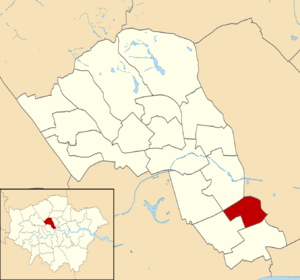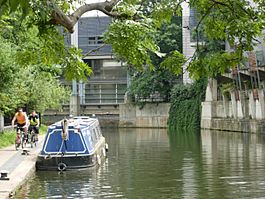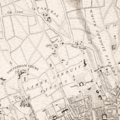King's Cross, London facts for kids
Quick facts for kids King's Cross |
|
|---|---|
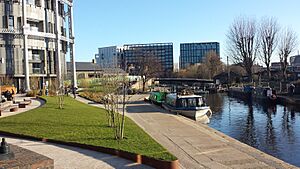 Repurposed gas holders and canal locks at King's Cross, with the buildings of St Pancras Square behind |
|
| Population | 11,843 (2011) |
| OS grid reference | TQ304827 |
| London borough | |
| Ceremonial county | Greater London |
| Region | |
| Country | England |
| Sovereign state | United Kingdom |
| Post town | LONDON |
| Postcode district | N1, N1C |
| Postcode district | NW1 |
| Postcode district | WC1 |
| Dialling code | 020 |
| Police | Metropolitan |
| Fire | London |
| Ambulance | London |
| EU Parliament | London |
| UK Parliament |
|
| London Assembly |
|
King's Cross is a lively area in London, England. It sits across two boroughs, Camden and Islington. You'll find it about 1.5 miles north of Charing Cross, which is right in the heart of London.
This area is famous for its two big train stations: St Pancras and King's Cross. King's Cross station is a main hub for trains heading north from London. Since the 1990s, King's Cross has been completely transformed. New buildings and spaces have replaced old railway lands. This change was boosted by the Eurostar train service moving to St Pancras International.
Contents
History of King's Cross
What was King's Cross called before?
Long ago, this area was known as Battle Bridge. It got this name from an old crossing over the River Fleet. The original bridge was called Broad Ford Bridge. Near the stations, you can find St Pancras Old Church. It's built on a small hill by the River Fleet. Many believe it's one of Britain's oldest Christian sites.
The Legend of Boudica at Battle Bridge
The name "Battle Bridge" led to a famous story. People believed a huge battle happened here around 60 or 61 AD. This battle was supposedly between the Romans and the Iceni tribe. The Iceni were led by the brave queen Boudica.
An ancient Roman historian, Publius Cornelius Tacitus, wrote about this battle. But he didn't say exactly where it took place. So, whether it was truly at Battle Bridge is a bit of a mystery! There's even a fun urban folklore story. It says Boudica is buried under platform 9 or 10 at King's Cross station.
Today, you can still find "Battle Bridge Place" between the two main stations. There's also "Brill Place" nearby. An interesting art piece called the Identified Flying Object (IFO) stands in Battle Bridge Place.
How King's Cross Got Its Name
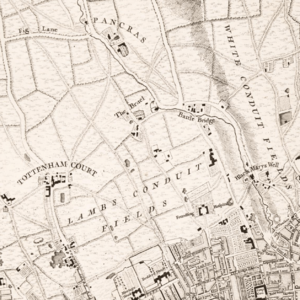
In 1746, maps showed King's Cross as open countryside. But then a new road, Euston Road, opened in 1756. This helped the area start to develop.
The name "King's Cross" comes from a large monument. It was built for King George IV. This monument stood from 1830 to 1845. It was at a busy crossroads where Euston Road, Gray's Inn Road, and Pentonville Road met.
The monument was 60 feet tall. It had an 11-foot statue of the king on top. People didn't really like the building. It was described as "ridiculous" and "absurd." The statue itself was made of bricks and mortar, made to look like stone. The architect was Stephen Geary. The top part of the monument was a camera obscura. The bottom part was first a police station, then a pub. The monument was taken down in 1845. But the area kept the name King's Cross.
Later, a building with a lighthouse-like structure was built nearby. It's known as the "Lighthouse Building." It's a special building protected for its history.
The Famous Railway Stations

King's Cross station is now located where the monument once stood. The station was designed by architect Lewis Cubitt. It opened in 1852. Before this, a temporary station was built for the Great Exhibition of 1851.
St Pancras railway station, built by the Midland Railway, is right next to King's Cross. Both stations had huge areas of land. These "railway lands" were used to handle goods like fish, coal, and grain. The passenger stations became very famous. But the movement of goods was also very important for London's economy.
King's Cross: From Decline to Renewal
After World War II, the King's Cross area changed. It went from a busy industrial area to a quieter, partly empty place. Many railway goods yards closed down. This made it hard to bring new life to the area.
However, artists and designers found the area appealing. Rents were cheaper, and it was still in central London. Famous artists like Antony Gormley and Thomas Heatherwick set up their studios here. In the late 1980s, a group called Mutoid Waste Company moved into a warehouse. They created huge sculptures from scrap metal and held parties.
In the 1990s, the government started projects to improve King's Cross. A big boost came in 2000 with work on High Speed 1. This is a fast train line. In 2007, the Eurostar international train service moved to St Pancras station. This brought even more attention to the area.
Today, King's Cross is still being redeveloped. Many new buildings have been built. For example, Google has a large new building here. The area is also home to many trade union offices.
Culture and Learning in King's Cross
King's Cross has become a hub for culture and education. The London Canal Museum opened in 1992. In 1997, the new British Library opened next to St Pancras station. This library holds millions of books and important documents.
The Gagosian Gallery, a famous art gallery, moved its main London location here in 2004. Music groups like the London Sinfonietta are based at King's Place. This building is next to Battlebridge Basin and the Regent's Canal. King's Place is also home to The Guardian and The Observer newspapers.
In 2011, the University of the Arts London moved to the Granary Complex. Many new public spaces have also opened. These include Granary Square with its amazing fountains, Lewis Cubitt Park, and the new Gasholder Park. The area has kept many of its historic buildings while adding modern ones.
Where is King's Cross?
King's Cross is in the southern part of the London Borough of Camden. It also extends into the London Borough of Islington. The importance of King's Cross station means that the name "King's Cross" is used for nearby areas too.
The eastern edge of the area follows the path of the River Fleet. The southern edge runs along Guilford Street. The London Borough of Camden has an electoral ward (a local voting area) called King's Cross. This ward covers part of the southern area. There are plans to make this ward bigger. It would then include the King's Cross and St Pancras stations. It would also include the large redeveloped area north of the stations.
King's Cross in Books and Movies
If you're a fan of Harry Potter, you'll know King's Cross station! It's where Harry boards the train for Hogwarts. The author, JK Rowling, later said she might have mixed it up with nearby Euston station. But King's Cross station has embraced its fame. You can find a sign for the fictional "Platform 9+3⁄4" there. There's even a luggage trolley that looks like it's halfway through the wall!
The area has also been featured in many films. These include the 1955 comedy The Ladykillers. Other films set here are A Cry from the Streets (1958) and Spare the Rod (1961). Mike Leigh's High Hopes (1988) and Anthony Minghella's Breaking and Entering (2006) also use King's Cross as their setting.
The Irish rock group the Pogues was also formed in King's Cross.
Getting Around King's Cross
King's Cross Train Station
King's Cross station is a very important train hub. It's a central point in the district.
Trains from King's Cross go to many places. Thameslink and Great Northern trains serve areas like Finsbury Park and Enfield Town. You can also travel further to places like Cambridge and King's Lynn. For longer journeys, Grand Central, Lumo, Hull Trains, and LNER operate services. These trains go to Yorkshire, North East England, and Scotland. You can reach cities like Leeds, Newcastle upon Tyne, and Edinburgh.
The Goods Yard complex at King's Cross was once a freight terminal. It was designed by Lewis Cubitt in 1852. The nearby Granary Square is named after the Granary building. Trains used to bring wheat from Lincolnshire here. The wheat was stored in the Granary building for London's bakers.
St Pancras International Train Station
St Pancras International station is also in the King's Cross area.
St Pancras is where the Eurostar trains leave for other countries. You can travel to Amsterdam, Brussels, and Paris from here.
The station also has fast Southeastern High Speed services. These trains connect to Kent and Stratford International. Stratford is where London's Queen Elizabeth Olympic Park is located.
Other long-distance trains are run by East Midlands Railway. They go to cities like Leicester and Sheffield.
Thameslink also runs regional services from St Pancras. These trains cross London and go to places like Bedford, Brighton, and Luton. They also connect to major London spots like Farringdon and London Bridge. These routes make it easy to get to Gatwick and Luton from King's Cross.
Euston Train Station (Nearby)
Euston station is about half a mile west of King's Cross. From Euston, you can catch trains to the West Midlands, North Wales, North West England, and Scotland. Destinations include Birmingham, Liverpool, Manchester, and Glasgow.
The London Overground also runs services from Euston. These trains go to Watford Junction.
A group has created a "Wellbeing Walk" between Euston and St Pancras stations. This route avoids the busy Euston Road. They say it reduces how much air pollution walkers breathe in by 50%.
King's Cross St Pancras Tube Station
King's Cross St Pancras tube station is a very busy underground station. It serves many London Underground lines:
- Circle, Hammersmith & City, and Metropolitan lines



- Northern line (Bank branch)

- Piccadilly line

- Victoria line

The Piccadilly line connects King's Cross directly to Heathrow Airport and the West End. The Circle, Hammersmith & City, Metropolitan, and Northern lines link the area to the City of London.
Euston tube station is also nearby. It's served by both branches of the Northern line and the Victoria line. Both King's Cross St Pancras and Euston stations are in London's Zone 1.
Buses and Coaches
King's Cross is a major transport hub. Many London Buses routes serve the area during the day. These include routes 17, 30, 46, 63, 73, 91, 205, 214, 259, 390, and 476.
National Express coach A8 connects King's Cross to Stansted Airport. Green Line coach 748 links the area to Hemel Hempstead in Hertfordshire.
Cycling Around King's Cross
King's Cross has several good cycle routes. The London Borough of Camden and Transport for London (TfL) maintain these paths.
Cycleway 6 runs north and south. It passes along Midland Road and Judd Street. Going north, it leads towards Kentish Town. Going south, it connects King's Cross to Farringdon and the City.
The Regent's Canal Towpath is also great for cycling. You can cycle west from King's Cross to Camden Lock and Regent's Park. If you want to go east, you need to bypass the Islington Tunnel through Angel. But the path continues towards Hoxton and Victoria Park.
There are many places to park your bike. You can also use bicycle-sharing systems like Santander Cycles.
Main Roads in King's Cross
King's Cross is at a busy junction where several main roads meet:
- A201 King's Cross Road (Southbound: to Farringdon, the City, Elephant & Castle)
- A501 Euston Road/Pentonville Road (Westbound: to Euston, Marylebone; Eastbound: to Angel, the A1)
- A5200 York Way/Gray's Inn Road (Northbound: to Barnsbury, Archway; Southbound: to Bloomsbury, Holborn)
- A5202 Pancras Road (Northbound: to Camden Town, Kentish Town)
- A5203 Caledonian Road (Northbound: to Islington, Holloway)
- B512 Crowndale Road (Westbound: to Camden Town)
You might recognize Euston Road and Pentonville Road. They are both on the London edition of the game, Monopoly.
Camden Highline Project
A new park is being planned called the Camden Highline. It will use an old railway line between Camden Town and King's Cross. Planning permission for this exciting project was given in January 2023.
Fun Places to Visit Nearby
- Platform 9 3/4 (at King's Cross Station)
- The British Library
- Camley Street Natural Park
- London Canal Museum
- St Pancras Old Church
- King's Place
- Charles Dickens Museum
- The Foundling Museum
- Gagosian Gallery
- Gasholder No. 8
- Coal Drops Yard (a shopping area)
Images for kids





